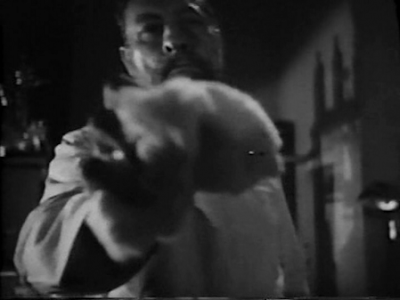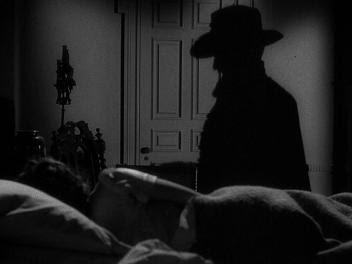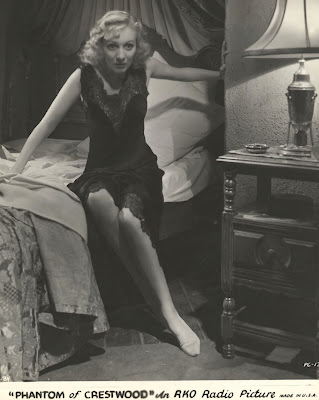The best sequels such as GODFATHER 2 transcend expectations, disappointing on an existential level at first, until their own different brilliance shines through. HALLOWEEN 2 goes the reverse and delivers, in the vernacular of Chico Marx "ah-too-a much,"pleasing audiences at first but leaving them sick of the whole business by the end.
In HALLOWEEN II's case, it's in the imitation of the imitators of John Carpenter's original (such as Friday the 13th) that if falters. Instead of zeroing in on the method rather than just the madness, director Rick Rosenthal tries to compensate for lack of know-how vis-a-vis suspenseful build-up, by heaping on the corpses and coincidence. A whole cross section of stock characters are set up to be slaughtered and then slaughtered. Some of them are so gross (the goomba EMT) we cheer their deaths, but some of whom we come to like--in the short time we have with them-- which just makes their clumsy offing dispiriting rather than terrifying.
The two holdovers from the original, Jamie Lee and Donald Pleasance, struggle to transcend this stale nightmare they've inadvertently found themselves locked into; they're like the only awake people in one of those feverish afternoon dreams where you spend the whole time trying to find the bathroom and everyone ignores you until you find it, but the whole thing is flooded. Feverishly, you navigate mazes of institutional gray halls.... slowly bursting from within. And on reflection, the idea that a mass murder would go on in a small town and the hospital not be overloaded with firemen, cops and press, seems ridiculous, even in the era before CNN.
 |
| settin' em up, knockin' 'em down |
But as kids don't know what kind of work it took to make the original killings so keenly 'felt' in their retellings, hack directors can only mirror the surfaces, every attempt at 'difference' diluting their strength: the score's eerie piano theme is revamped to less effect as an Emerson Lake-style synthesizer; the William Shatner mask is given a tacky blonde hair paint job; the eerie jack-o-lantern behind the opening credits is now somehow less scary with rounder edges on the eyes; the Steadicam POV shots now go nowhere, except up and down marble halls. Additions from FRIDAY THE 13TH are even brought in: the hospital staff includes the aforementioned foulmouthed Italian American douchebag paramedic and his cute shy college boy paramedical partner; the bossy-but-compassionate African American nurse; a candy stripe hottie (passive enough to shag the douche), and the cliche'd fat oaf security guard (the same guard from Sarah's psych ward in TERMINATOR 2!)... all set up just to get knocked down before the ball even comes back up the chute.
 |
| what a speller! |
But it's all pretty absurd that, with all the murders going on, anyone would even waste time at the school, combing blackboards for obscure messages. Why on Earth don't they post some cops outside Laurie's room in the hospital instead of weaving through grade schools?
The opening, which includes the last few minutes of the end of the first film, starts strong with elaborate tracking shots through the neighborhood night. The wounded Myers steals a knife out of a kitchen while an old lady's back is turned, but he doesn't kill her... she's not young or on the phone with her boyfriend, unlike her neighbor. But Myers' killing for the rest of the film is more focused. He just wants to kill everyone at a public hospital night shift. Period.

The new Shout Blu-ray gives these corridors of the hospital a 3-D clarity: the gleaming wax of the institutional floors and overhead florescent lights make a subtextual commentary on the aesthetic barrenness of cash-in sequels like this one (until that is, Michael cuts the power). So there are some great tracking shots as the night crew of the hospital come into work, walking through the long corridors like they've done a hundred times before, to sign in and deal with their mundane tasks. The wounded Laurie Strode is admitted; the killer moseys over; Donald Pleasance does his quivering voiced 'this isn't a man, it's a demon!" business but never thinks to hang out at the hospital.
 |
| In case you are wondering, these screenshots were all taken from the theatrical version - an alternate TV cut with added scenes and presented full screen. |
Getting back to Halloween razor blade side bit, let us use it as a segue back into discussing the years of 1979-1983 when--fueled by an alarmist press and helped in no small part by the tide of slasher movies imitating HALLOWEEN and FRIDAY THE 13TH, now available also on video and premium cable as well as theaters--parents and small children began to feel really spooked by imagining that everyone but them were getting off on seeing teenage girls butchered. Suddenly the newspapers were alive with tales of suburban Satanic pedophiles rings! Your whole town could be one Satanic cult and you the only one left out! We kids trembled in our beds and kept butcher knives by our sides at night, and the freedom my generation enjoyed in the 70s-- when we were expected to go roaming unsupervised throughout the neighborhood once we turned the ripe age of seven--was gradually, through media bandwagon hysteria--eliminated in favor of the helicopter play date supervision we have now. Of course the worries about things like pedophile rings turned out to be false recovered memories, and the razors in the apples was a downright myth perpetrated by Ann Landers:
Despite the falsity of these claims (the razor apple bit - EK) the news media promoted the story continuously throughout the 1980s, with local news stations featuring frequent coverage. During this time cases of poisoning were repeatedly reported based on unsubstantiated claims or before a full investigation could be completed and often never followed up on. This one sided coverage contributed to the overall panic and caused rival media outlets to issue reports of candy tampering as well.
By 1985, the media had driven the hysteria about candy poisonings to such a point that an ABC News/Washington Post poll that found 60% of parents feared that their children would be injured or killed because of Halloween candy sabotage.
Advice columnists entered the fray during the 1980s and 1990s with both Ann Landers and Dear Abby warning parents of the horrors of candy tampering
"In recent years, there have been reports of people with twisted minds putting razor blades and poison in taffy apples and Halloween candy. It is no longer safe to let your child eat treats that come from strangers." –Ann LandersAs someone who loved trick-or-treating but had by 1982 grown too old for it, I would drive around the neighborhood on Halloween, bored and restless, noticing with horror how the amount of trick or treaters in my NJ neighborhood had, by 1983, had trickled off to a few scattered throngs--and everyone was finished before dark. Just a few years earlier my crew and I would race around unsupervised until all hours and even our parents would tell us it wasn't appropriate to start out until after dinner and it had gotten dark.
"Somebody's child will become violently ill or die after eating poisoned candy or an apple containing a razor blade." –Dear Abby
This collective fear also served as the impetus for the "safe" trick-or-treating offered by many local malls --- (Wiki)
But one door never closes but that another opens. Kids may have lost their freedom to go outside unchaperoned, but it was concurrent with the arrival of VHS and cable, which acted as the partial cause of --and cure for --this Halloween depression. I sulked through the rest of my tweenage life with only the VCR as a life preserver and though I never liked it, HALLOWEEN II was ever-present, it was just on HBO all the time, over and over. So even now, whenever I hear "Mr. Sandman / build me a dream" I see Michael's mask burning in the exploded hospital room.
So that was 1982: The cable / VCR double threat made most any film available to see anytime, at home; the need and/or desire to 'tell' a film to someone else vanished accordingly. And just like the sequel only reproduces the remembered killings and loses all the unique aspects which Carpenter brought to bear to make the original truly scary, so too we don't think we're losing anything by scrapping telling scary stories to each other by firelight, since we don't need imagination to see the killings now.
But hearing them from our friends, told by fires at camp or candles and flashlights at home, once fueled our imagination and made them both scarier and less traumatizing than seeing the films would prove. None ever measured up to our lurid envisioning when we finally were old enough to see them. But, still, seeing them did something to us: it left us feeling that stale, wretched one-night-stand loss of faith in humanity instead of the swooning no-release all-night make-out session of the campfire narrative.

Though we don't get any indication Myers is still alive at the end of this one, of course he would be back. Twenty years later and Curtis returned to finally and forever kill him--until he came back, of course, again and again, each time the last. Today, those uneasy eyes are gone but the blonde hair remains, super long now, like Rob Zombie likes it, and the final girl chase and battle drags on until both parties are cut to ribbons and beyond, but in the early 1980s, the tangy smell of my little (blonde) brother's garage mechanic grime and cold oil from the garage and mom's at-home perms despoiling my nose, watching HALLOWEEN II (the only film my brother Fred ever taped) over and over, the sheer hopelessness of ever truly killing the evil suburbia hid in its basements, that terrifying Chordettes song echoing through the house --all of it dissolving into a lurching pastel spandex headband aerobics and Betamax decade; the 70s iron-straight blonde hair gone perm-pouffy; the hope of a Beatles reunion gone to Yoko's national moment of silence; friendly human contact gone to media crucifixion over a single lewd wink; a hundred thousand flamboyant dancing drunk devils gone to a sobering silent still AIDS angel; mischief night and trick-or-treating gone to the video tape. Rewind all you want, but we'll never bite into its razorblade core again.















































